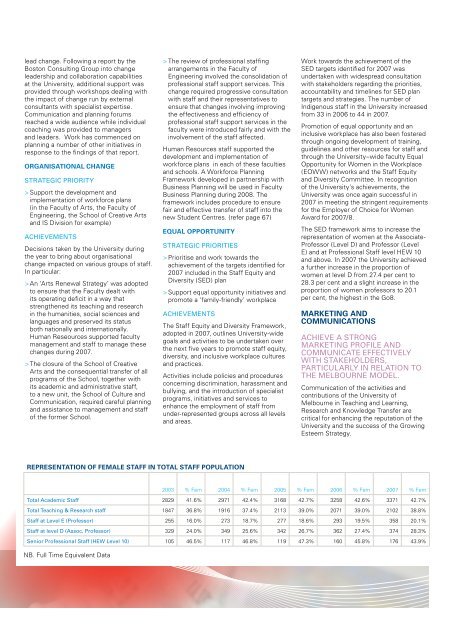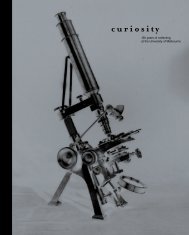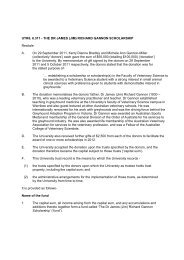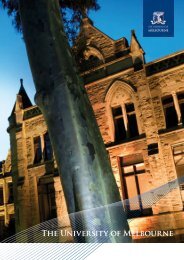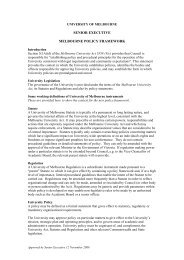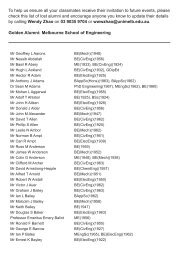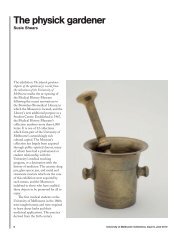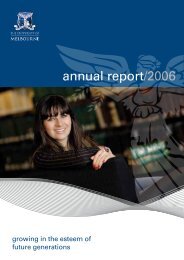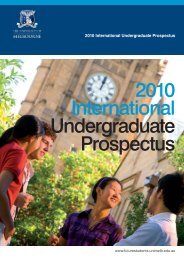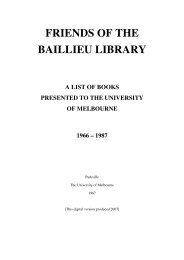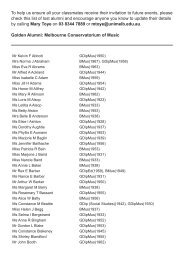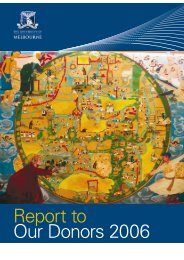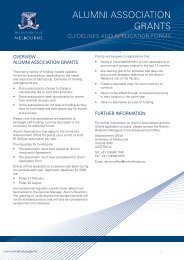2007 Annual report (PDF 8.1 Mb) - University of Melbourne
2007 Annual report (PDF 8.1 Mb) - University of Melbourne
2007 Annual report (PDF 8.1 Mb) - University of Melbourne
Create successful ePaper yourself
Turn your PDF publications into a flip-book with our unique Google optimized e-Paper software.
lead change. Following a <strong>report</strong> by the<br />
Boston Consulting Group into change<br />
leadership and collaboration capabilities<br />
at the <strong>University</strong>, additional support was<br />
provided through workshops dealing with<br />
the impact <strong>of</strong> change run by external<br />
consultants with specialist expertise.<br />
Communication and planning forums<br />
reached a wide audience while individual<br />
coaching was provided to managers<br />
and leaders. Work has commenced on<br />
planning a number <strong>of</strong> other initiatives in<br />
response to the findings <strong>of</strong> that <strong>report</strong>.<br />
Organisational Change<br />
Strategic Priority<br />
> Support the development and<br />
implementation <strong>of</strong> workforce plans<br />
(in the Faculty <strong>of</strong> Arts, the Faculty <strong>of</strong><br />
Engineering, the School <strong>of</strong> Creative Arts<br />
and IS Division for example)<br />
Achievements<br />
Decisions taken by the <strong>University</strong> during<br />
the year to bring about organisational<br />
change impacted on various groups <strong>of</strong> staff.<br />
In particular:<br />
> An ‘Arts Renewal Strategy’ was adopted<br />
to ensure that the Faculty dealt with<br />
its operating deficit in a way that<br />
strengthened its teaching and research<br />
in the humanities, social sciences and<br />
languages and preserved its status<br />
both nationally and internationally.<br />
Human Reseources supported faculty<br />
management and staff to manage these<br />
changes during <strong>2007</strong>.<br />
> The closure <strong>of</strong> the School <strong>of</strong> Creative<br />
Arts and the consequential transfer <strong>of</strong> all<br />
programs <strong>of</strong> the School, together with<br />
its academic and administrative staff,<br />
to a new unit, the School <strong>of</strong> Culture and<br />
Communication, required careful planning<br />
and assistance to management and staff<br />
<strong>of</strong> the former School.<br />
> The review <strong>of</strong> pr<strong>of</strong>essional staffing<br />
arrangements in the Faculty <strong>of</strong><br />
Engineering involved the consolidation <strong>of</strong><br />
pr<strong>of</strong>essional staff support services. This<br />
change required progressive consultation<br />
with staff and their representatives to<br />
ensure that changes involving improving<br />
the effectiveness and efficiency <strong>of</strong><br />
pr<strong>of</strong>essional staff support services in the<br />
faculty were introduced fairly and with the<br />
involvement <strong>of</strong> the staff affected.<br />
Human Resources staff supported the<br />
development and implementation <strong>of</strong><br />
workforce plans in each <strong>of</strong> these faculties<br />
and schools. A Workforce Planning<br />
Framework developed in partnership with<br />
Business Planning will be used in Faculty<br />
Business Planning during 2008. The<br />
framework includes procedure to ensure<br />
fair and effective transfer <strong>of</strong> staff into the<br />
new Student Centres. (refer page 67)<br />
Equal Opportunity<br />
Strategic Priorities<br />
> Prioritise and work towards the<br />
achievement <strong>of</strong> the targets identified for<br />
<strong>2007</strong> included in the Staff Equity and<br />
Diversity (SED) plan<br />
> Support equal opportunity initiatives and<br />
promote a ‘family-friendly’ workplace<br />
Achievements<br />
The Staff Equity and Diversity Framework,<br />
adopted in <strong>2007</strong>, outlines <strong>University</strong>-wide<br />
goals and activities to be undertaken over<br />
the next five years to promote staff equity,<br />
diversity, and inclusive workplace cultures<br />
and practices.<br />
Activities include policies and procedures<br />
concerning discrimination, harassment and<br />
bullying, and the introduction <strong>of</strong> specialist<br />
programs, initiatives and services to<br />
enhance the employment <strong>of</strong> staff from<br />
under-represented groups across all levels<br />
and areas.<br />
Work towards the achievement <strong>of</strong> the<br />
SED targets identified for <strong>2007</strong> was<br />
undertaken with widespread consultation<br />
with stakeholders regarding the priorities,<br />
accountability and timelines for SED plan<br />
targets and strategies. The number <strong>of</strong><br />
Indigenous staff in the <strong>University</strong> increased<br />
from 33 in 2006 to 44 in <strong>2007</strong>.<br />
Promotion <strong>of</strong> equal opportunity and an<br />
inclusive workplace has also been fostered<br />
through ongoing development <strong>of</strong> training,<br />
guidelines and other resources for staff and<br />
through the <strong>University</strong>–wide faculty Equal<br />
Opportunity for Women in the Workplace<br />
(EOWW) networks and the Staff Equity<br />
and Diversity Committee. In recognition<br />
<strong>of</strong> the <strong>University</strong>’s achievements, the<br />
<strong>University</strong> was once again successful in<br />
<strong>2007</strong> in meeting the stringent requirements<br />
for the Employer <strong>of</strong> Choice for Women<br />
Award for <strong>2007</strong>/8.<br />
The SED framework aims to increase the<br />
representation <strong>of</strong> women at the Associate-<br />
Pr<strong>of</strong>essor (Level D) and Pr<strong>of</strong>essor (Level<br />
E) and at Pr<strong>of</strong>essional Staff level HEW 10<br />
and above. In <strong>2007</strong> the <strong>University</strong> achieved<br />
a further increase in the proportion <strong>of</strong><br />
women at level D from 27.4 per cent to<br />
28.3 per cent and a slight increase in the<br />
proportion <strong>of</strong> women pr<strong>of</strong>essors to 20.1<br />
per cent, the highest in the Go8.<br />
Marketing and<br />
Communications<br />
Achieve a strong<br />
marketing pr<strong>of</strong>ile and<br />
communicate effectively<br />
with stakeholders,<br />
particularly in relation to<br />
the <strong>Melbourne</strong> Model.<br />
Communication <strong>of</strong> the activities and<br />
contributions <strong>of</strong> the <strong>University</strong> <strong>of</strong><br />
<strong>Melbourne</strong> in Teaching and Learning,<br />
Research and Knowledge Transfer are<br />
critical for enhancing the reputation <strong>of</strong> the<br />
<strong>University</strong> and the success <strong>of</strong> the Growing<br />
Esteem Strategy.<br />
Representation <strong>of</strong> Female Staff in Total Staff Population<br />
2003 % Fem 2004 % Fem 2005 % Fem 2006 % Fem <strong>2007</strong> % Fem<br />
Total Academic Staff 2829 41.6% 2971 42.4% 3168 42.7% 3258 42.6% 3371 42.7%<br />
Total Teaching & Research staff 1847 36.8% 1916 37.4% 2113 39.0% 2071 39.0% 2102 38.8%<br />
Staff at Level E (Pr<strong>of</strong>essor) 255 16.0% 273 18.7% 277 18.6% 293 19.5% 358 20.1%<br />
Staff at level D (Assoc. Pr<strong>of</strong>essor) 329 24.0% 349 25.6% 342 26.7% 362 27.4% 374 28.3%<br />
Senior Pr<strong>of</strong>essional Staff (HEW Level 10) 105 46.5% 117 46.8% 119 47.3% 160 45.8% 176 43.9%<br />
NB. Full Time Equivalent Data


